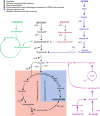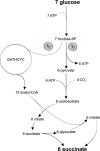Carbon efficient production of chemicals with yeasts
- PMID: 37997485
- PMCID: PMC10946752
- DOI: 10.1002/yea.3909
Carbon efficient production of chemicals with yeasts
Abstract
Microbial metabolism offers a wide variety of opportunities to produce chemicals from renewable resources. Employing such processes of industrial biotechnology provides valuable means to fight climate change by replacing fossil feedstocks by renewable substrate to reduce or even revert carbon emission. Several yeast species are well suited chassis organisms for this purpose, illustrated by the fact that the still largest microbial production of a chemical, namely bioethanol is based on yeast. Although production of ethanol and some other chemicals is highly efficient, this is not the case for many desired bulk chemicals. One reason for low efficiency is carbon loss, which decreases the product yield and increases the share of total production costs that is taken by substrate costs. Here we discuss the causes for carbon loss in metabolic processes, approaches to avoid carbon loss, as well as opportunities to incorporate carbon from CO2 , based on the electron balance of pathways. These aspects of carbon efficiency are illustrated for the production of succinic acid from a diversity of substrates using different pathways.
Keywords: bioeconomy; carbon balance; industrial biotechnology; metabolic engineering.
© 2023 The Authors. Yeast published by John Wiley & Sons Ltd.
Conflict of interest statement
The authors declare no conflict of interest.
Figures



References
-
- Bar‐Even, A. , Noor, E. , Flamholz, A. , & Milo, R. (2013). Design and analysis of metabolic pathways supporting formatotrophic growth for electricity‐dependent cultivation of microbes. Biochimica et Biophysica Acta (BBA) ‐ Bioenergetics, 1827(8–9), 1039–1047. 10.1016/j.bbabio.2012.10.013 - DOI - PubMed
-
- Baumschabl, M. , Ata, Ö. , Mitic, B. M. , Lutz, L. , Gassler, T. , Troyer, C. , Hann, S. , & Mattanovich, D. (2022). Conversion of CO2 into organic acids by engineered autotrophic yeast. Proceedings of the National Academy of Sciences, 119(47), e2211827119. 10.1073/pnas.2211827119 - DOI - PMC - PubMed
Publication types
MeSH terms
Substances
Grants and funding
LinkOut - more resources
Full Text Sources
Molecular Biology Databases
